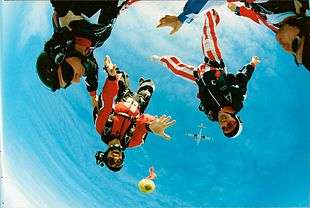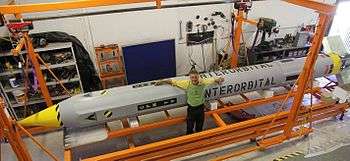Olav Zipser
Olav Zipser (born 12 March 1966, in Simmern, West Germany) is a highly accomplished, multiple-time world champion, trainer of multiple world champions, Sports Emmy Award-winning, pioneering skydiver.[1] [2]
Olav Zipser | |
|---|---|
 'Father of FreeFly' Olav Zipser FreeFlying with his Sports Emmy Award | |
| Born | 12 March 1966 Siemern, West Germany |
| Nationality | German |
| Other names | 'Father of FreeFly' |
| Occupation | International Master FreeFlyer |
| Known for | Founding and developing Freeflying, Space Games |
| Awards | Sports Emmy 1995 X-Games |
Zipser spearheaded the FreeFly revolution of the early 1990s [3]when he began experimenting with non-traditional forms of body flight. Since then, he has been part of the worldwide sport of FreeFly, and has helped it grow to the Fédération Aéronautique Internationale competition level that it is at today. He is respectfully known as "The Father of FreeFly".[4][5]
Zipser is the founder of the FreeFly Training and Instruction Program, of The First School of Modern SkyFlying, of the Atmosphere Dolphin FreeFly Licence Program, of the Space Games, and of The FreeFly Astronaut Project. He was also the first to make use of Space Balls to train and test freeflyers to an international standard.[6]
Zipser completed his 21,000th skydive at Skydive Dubai UAE in 2012;[7][8] as of June 2015 he has logged more than 22, 750 skydives.[9] He has flown in 25 of the world's wind tunnels,[10] has won more than 51 gold medals from various international skydiving competitions,[11] has trained no less than 14 world champion skydivers from around the world,[12] and has flown his human body the equivalent of almost three times around the Earth at the equator.[13][14]
Zipser is a synergist with the Human Synergy Project, a diverse community of artists, scientists, adventurers, visionaries, free thinkers, performers and writers.[15] He is also a test pilot and astronaut in training with Team Synergy Moon (a Google Lunar X-Prize official team).[16][17]
The Birth of FreeFly
Zipser started skydiving in the experimental phase of the Accelerated Freefall progression skydiving program in 1986, and immediately began experimenting with non-traditional forms of body flight. He studied and trained human aerodynamics for four months in a wind tunnel. From that experience he developed a new concept of human body flight, which he called FreeFly. First he trained friends, then he developed a professional FreeFly Training and Instruction Program so he could train others to become FreeFly teachers and instructors.[18] [19]
The First School of Modern SkyFlying
Main article The First School of Modern SkyFlying
With the objective of researching, documenting, developing, teaching, training, and pushing the envelope of human flight capability, Zipser founded The First School of Modern SkyFlying in 1994. He came up with the idea of using Space Balls as independent measuring devices for constant speed (155 mph) and direction (straight down). These measurements train and test freeflyers so that they can meet an advanced international standard.[20]
The Atmosphere Dolphin FreeFly Licence Program

Consisting of advanced human flight performance tests / a series of predetermined high speed aerobatic freefly manoeuvres around and with at first one then two Space Balls, in 1996 Zipser developed the Atmosphere Dolphin FreeFly Licence Program and awarded Atmosphere Dolphin FreeFly Licenses AD-A to AD-D. This provided the testing ground for the research and development of freeflying, and opened up the possibility for a number of high-speed human flight air games and competitions.[21]
Through March 2007, a total of 410 FreeFlyers from 32 nations have achieved Atmosphere Dolphin FreeFly licences. Four of those have earned Atmosphere Dolphin AD-D licences.[22]
The Space Games
Main article Space Games
In the early days of FreeFlying, Zipser wanted to bring together the world's then-best freeflyers to research, develop, and document the performance evolution of human freeflight, or freeflying.
So he devised the first human flight races, air games and competitions. Each has an open-class and a pro-class, based on his Atmosphere Dolphin FreeFly Tests. He also founded the Space Games, which incorporates double-elimination, one-on-one races; open rounds; competition rounds; the FreeFly Indie 500; the FreeFly Atmosphere Dolphin Challenge; Fastest, Slowest and Furthest competitions; Freestyle; Sky Surf; and 3way and 4way FreeFly Challenges.[23]
The first Space Games was held in 1997 at Skydive America Palm Beach in Pahokee, Florida.[24]
A total of 16 Space Games events were held between 1997 and 2004. The resulting recognition and following brought FreeFlying into the international public eye, and took the competition to the next level.
So far, Space Games cash prizes totaling as much as US$35 000 per event have been awarded to winners of different categories.
FreeFly Officially Recognised
In 2000 FreeFlying become officially recognised as an aviation discipline by Fédération Aéronautique Internationale, opening up the possibility for official National Championships and World Championships in FreeFly.
Zipser took gold at America's first official FreeFly National Skydiving Championships in 2000. He took gold again at the first official Fédération Aéronautique Internationale FreeFly World Skydiving Championships and World Air Games, held in Spain in 2001.[25]
Also in 2001, Zipser introduced FreeFly at the World Games (under the patronage of the Olympic Games) in Japan. That introduction led to Olympic recognition of FreeFlying and to FreeFlying being included in the 2005 World Games in Germany.
Stratosphere Skydive
In 1995 Zipser became the first civilian to skydive from the stratosphere when he jumped from an Ilyushin 76 at 41,667 feet over central Russia.[26] He performed the skydive with Patrick de Gayardon for Sector No Limits Sports Watches. They set the record for exiting an aircraft from the highest altitude without oxygen and achieved FreeFly speeds of 750kmh.[27] [28][29]
Sports Emmy Award
Zipser received a Sports Emmy Award from the National Academy of Television Arts and Sciences in 1995 for his performance and aerial cinematography of ESPN's inaugural X Games that summer.[30]
FreeFly Astronaut Project

Founded by Olav Zipser In 2009, The FreeFly Astronaut Project is a scientific research mission toward the development of appropriate techniques and survival suits for high-altitude and low-earth-orbit emergency re-entry survival and rescue situations.[31]
The aim of the project is to develop a safe and economical emergency return and rescue method to improve the odds of survival for mankind's future space pioneers and tourists in the event of a space emergency.[32][33]
The FreeFly Astronaut Project will forgo the balloon-lift method utilised by the current record holders, Felix Baumgartner with Red Bull Stratos (highest skydive) and Joe Kittinger with Project Excelsior (longest freefall). Instead, it will make use of specially modified InterOrbital Systems SR 145 rockets to propel Team Synergy Moon test pilot and astronaut-in-training Olav Zipser[34] to increasingly higher altitudes (higher than any manned balloon can possibly go). At those high altitudes, Zipser will employ the FreeFly techniques—developed and tested over his 26-year, 21,000-jump skydiving career—to control his descent to Earth.[35]
The FreeFly Astronaut Project has committed to five rocket launches to increasingly higher altitudes, culminating with a FreeFly reentry from above the Karman Line (100 km)—a real space altitude. Zipser will be the first person to jump from a rocket, and will break and set numerous official Fédération Aéronautique Internationale skydiving, aeronautics and astronautics records with each launch.

Launches will take place from InterOrbital Systems facilities at the Mojave Air and Space Port.[36] The first launch is planned to 45 km (131,000 feet).
Russian spacesuit manufacturer Zvezda is providing Zipser with a specially modified Orlan Series spacesuit for his FreeFly mission.[37]
In 2011, Zipser spent an undisclosed amount of time at the Yuri Gagarin Cosmonaut Training Center in Russia for training and collaboration on the development of a supersonic spacesuit to be used as an economical rescue and return alternative for astronauts and space tourists.[38][39][40][41]
Skydive for Rhinos
When Zipser traveled to South Africa in 2012 for The Ranch SkyDiving Boogie and Symposium held at The Ranch Resort to give a presentation on the FreeFly Astronaut Project, he was exposed to the rhino poaching crisis. He came on board as an International Skydive for Rhinos Ambassador with African Conservation Trust's Skydive for Rhinos campaign.
The initiative raised R6.6 million South African Rand for strategic rhino anti-poaching efforts in South Africa.[42][43][44]
References
- British Parachute Association article, retrieved 10 Sep 2012
- http://parachutistonline.com/columns/profiles/olav-zipser-d-11733 Archived 15 July 2015 at the Wayback Machine Parachutist Online Olav Zipser Profile, retrieved 4 June 2015
- http://parachutistonline.com/columns/profiles/olav-zipser-d-11733 Archived 15 July 2015 at the Wayback Machine Parachutist Online Olav Zipser Profile, retrieved 4 June 2015
- Pilots Post article, retrieved 10 Sep 2012
- http://www.amazers.co/users/olav-zipser%5B%5D Olav Zipser Amazers interview, retrieved 15 March 2014
- British Parachute Association article, retrieved 10 September 2012
- Emirates News Report 20 000th jump 2010
- Emirates News 2012 - watch from 15 min 40 sec
- http://parachutistonline.com/columns/profiles/olav-zipser-d-11733 Archived 15 July 2015 at the Wayback Machine Parachutist Online Olav Zipser Profile, retrieved 4 June 2015
- http://www.amazers.co/users/olav-zipser%5B%5D Olav Zipser Amazers interview, retrieved 15 March 2014
- "Olav Zipser Awards and Medals". Archived from the original on 17 July 2012. Retrieved 4 January 2013.
- "First School of Modern SkyFlying". Archived from the original on 10 September 2012. Retrieved 4 January 2013.
- http://www.amazers.co/users/olav-zipser%5B%5D Olav Zipser Amazers interview, retrieved 15 March 2014
- http://www.spacesafetymagazine.com/2014/01/10/interview-olav-zipser-freefly-astronaut-project/ International Association for the Advancement of Space Safety Interview with Olav Zipser, retrieved 15 March 2014
- Human Synergy Project
- Synergy Moon Team, retrieved 31 October 2012
- FreeFly Astronaut Project, retrieved 31 October 2012
- "Awards and Medals". Archived from the original on 17 July 2012. Retrieved 4 January 2013.
- Catching up with Olav Zipser
- "The First School of Modern SkyFlying". Archived from the original on 10 September 2012. Retrieved 4 January 2013.
- "Atmosphere Dolphin Human Flight Performance Tests". Archived from the original on 12 November 2012. Retrieved 4 January 2013.
- "Atmosphere Dolphin Licences issued". Archived from the original on 12 November 2012. Retrieved 4 January 2013.
- Space Games
- Space Games Development
- "Awards and Medals". Archived from the original on 17 July 2012. Retrieved 4 January 2013.
- YouTube video, retrieved 14 Dec 2012
- Stratosphere Space Flight Webpage and Magazine Article, retrieved 14 Dec 2012
- Google Lunar X-Prize Synergy Moon Blog, retrieved 14 Dec 2012
- http://www.spacesafetymagazine.com/2014/01/10/interview-olav-zipser-freefly-astronaut-project/ International Association for the Advancement of Space Safety Interview with Olav Zipser, retrieved 15 March 2014
- Emmy Award Certificate, retrieved 10 Sep 2012
- Spaceports Blog FreeFly Astronaut Project
- Pilots Post FreeFly Astronaut Project
- Sat Magazine FreeFly Astronaut Project
- Team Synergy Moon Olav Zipser
- Moon and Back FreeFly Astronaut Project
- "Olav Zipser: Free Fly Astronaut Project". interorbital.com. 2014. Archived from the original on 23 November 2014. Retrieved 21 November 2014.
- Moon and Back FreeFly Astronaut Project
- Olav Zipser Spacesuit Testing Russia
- Synergy Moon FreeFly Astronaut Project
- Olav Zipser Spacesuit Testing Russia 2
- http://www.spacesafetymagazine.com/2014/01/10/interview-olav-zipser-freefly-astronaut-project/ International Association for the Advancement of Space Safety Interview with Olav Zipser, retrieved 15 March 2014
- Skydive for Rhinos December Newsletter, retrieved 14 Dec 2012
- Skydive for Rhinos October Newsletter, retrieved 14 Dec 2012
- Parachute Association of South Africa Toggle Times Newsletter Issue 19, retrieved 14 Dec 2012
External links
- International Association for the Advancement of Space Safety - Interview with Olav Zipser, retrieved 15 March 2014
- Parachutist Online - Olav Zipser Profile, retrieved 4 June 2015
- Cypress Aero - Catching up with Olav Zipser, retrieved 9 Jan 2018